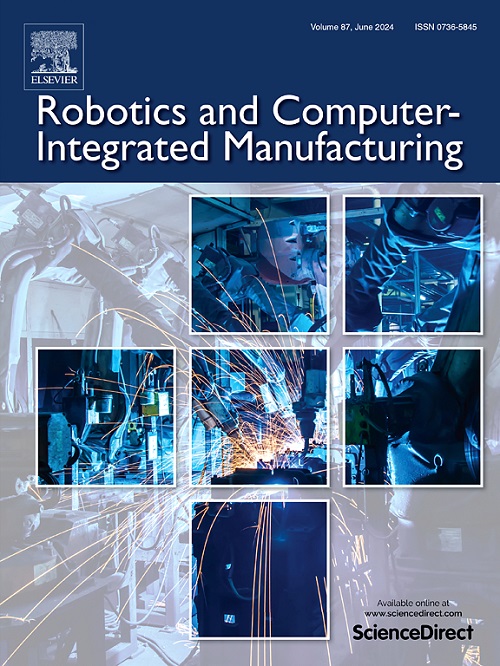多二次曲面噪声点云的曲面分割与焊缝提取
IF 11.4
1区 计算机科学
Q1 COMPUTER SCIENCE, INTERDISCIPLINARY APPLICATIONS
引用次数: 0
摘要
二次曲面是焊接中最常用的曲面类型。从一个单一的三维点云中提取由二次曲面形成的多个焊缝是复杂焊接机器人焊接中必不可少的和具有挑战性的一步。相关研究多集中在单一类型二次型焊缝的焊缝提取上。对于一般二次曲面的焊缝,需要一种焊缝提取方法。(1)提出了一种适用于各种二次曲面的二次拟合方法,有效地求解了具有线性方程的二次曲面模型。从试验结果可以看出,随着点云噪声的增大,本文方法的拟合误差以文献中奇异值分解方法的1/5左右的速率增长;本文提出的方法使操作效率提高了约40%。(2)针对具有多个二次曲面相交的噪声点云,提出了一种基于区域增长的二次曲面分割方法。与文献中的ICP注册方法相比,所提出的分割方法在测试期间减少了30% ~ 50%的分割错误。(3)提出了一种基于ETVPS (End Tangent Vector Projection Sorting)的区域增长方法,用于从分割的二次曲面中提取无组织的原始交点进行焊缝提取。所有这些方法都通过物理焊接的固体实验进行了验证。所提出的焊缝提取方法对噪声点云和缺陷点云具有较强的鲁棒性。本文章由计算机程序翻译,如有差异,请以英文原文为准。
Surface segmentation and weld extraction on noisy point clouds consisting of multiple quadrics
Quadrics are the most common types of surfaces used in weldments. Extracting multiple welds formed by quadric surfaces from a single 3D point cloud is an essential and challenging step in robotic welding for complex weldments. Relevant studies mostly focus on weld extraction from weldments with a single type of quadric. A weld extraction method for weldments with general quadratic surfaces is required. (1) This paper proposes a quadric fitting method for all kinds of quadrics, efficiently solving the quadric models with linear equations. It can be observed from the test results that the fitting error of the method proposed in this paper grows at a rate of about 1/5 of that of the SVD method in the literature as the point cloud noise grows; and the method proposed in this paper improves the operating efficiency by about 40 %. (2) For noisy point clouds with multiple intersecting quadrics, a quadric segmentation method based on region growing is proposed. The proposed segmentation method reduces 30 % ∼ 50 % of segmentation errors during the tests compared to the ICP registration approach in the literature. (3) A region growing method based on ETVPS (End Tangent Vector Projection Sorting) for weld extraction with the unorganized raw intersection points from the segmented quadrics is proposed. All the mentioned methods are verified with solid experiments with physical weldments. The proposed weld extraction method proves to be robust to noisy and defective point clouds.
求助全文
通过发布文献求助,成功后即可免费获取论文全文。
去求助
来源期刊
CiteScore
24.10
自引率
13.50%
发文量
160
审稿时长
50 days
期刊介绍:
The journal, Robotics and Computer-Integrated Manufacturing, focuses on sharing research applications that contribute to the development of new or enhanced robotics, manufacturing technologies, and innovative manufacturing strategies that are relevant to industry. Papers that combine theory and experimental validation are preferred, while review papers on current robotics and manufacturing issues are also considered. However, papers on traditional machining processes, modeling and simulation, supply chain management, and resource optimization are generally not within the scope of the journal, as there are more appropriate journals for these topics. Similarly, papers that are overly theoretical or mathematical will be directed to other suitable journals. The journal welcomes original papers in areas such as industrial robotics, human-robot collaboration in manufacturing, cloud-based manufacturing, cyber-physical production systems, big data analytics in manufacturing, smart mechatronics, machine learning, adaptive and sustainable manufacturing, and other fields involving unique manufacturing technologies.

 求助内容:
求助内容: 应助结果提醒方式:
应助结果提醒方式:


